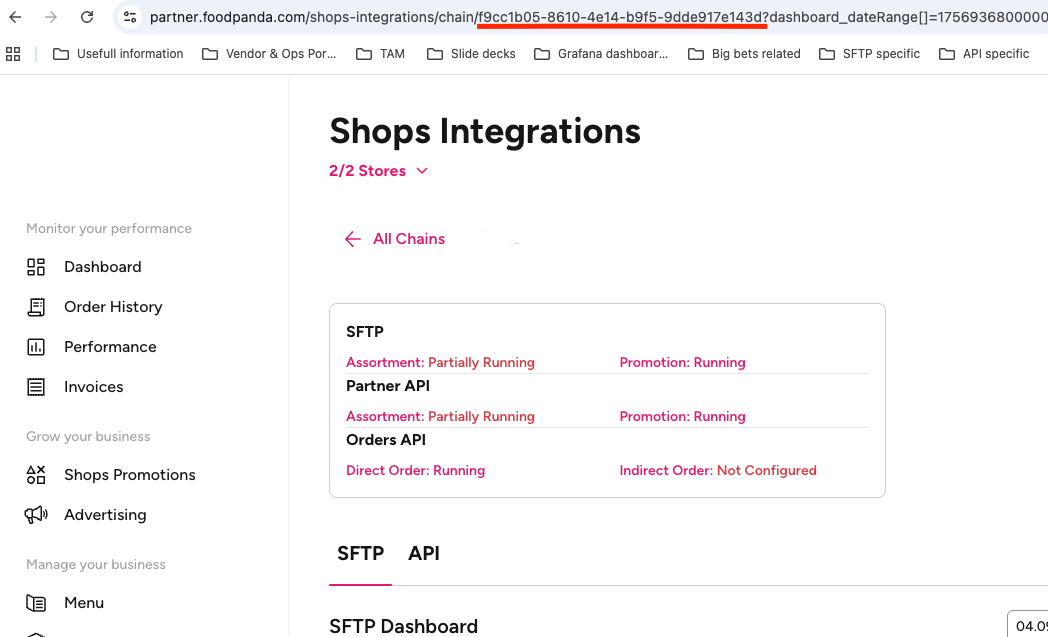API
Manage Incoming Orders
Manage your Catalog of products
SFTP
Manage your Catalog of products
Manage your Promotions
How to Integrate#
This section covers the basics of how to integrate. Click these links below to access each section of the integration process as required, or simply scroll down the page:
Integration prerequisites#
To be eligible for this integration, you must have the following:
API Development Capability – The ability to develop an API in-house or access third-party support for API development
Technical Readiness – You must have the technical capacity and infrastructure to receive order updates to your webhook
If you satisfy both of these requirements, you are ready & able to start the integration journey.
To integrate with our Partner API, you also must be one of our partners and ensure that you have:
Access to Partner Portal: A back office tool by which you can monitor orders, store operations, export orders, manage assortment across multiple stores.
Click here for more information on what’s Partner Portal
Access to the Integrations Plugin: Allows you to configure webhook and generate webhook.
Click here for more information on how to access the Shops Integrations Plugin
Possess an Active Store: You should have store setup in our platform and corresponding
integration typeconfigurations to be enabled in our catalog (check with your Account Manager)
Account Managers must select integration type configurations options from our Catalog Indirect POS Integration, should be selected for Pelican Picking Integration
What do you need to develop to complete the integration?#
At the high level, there are two things you need to do:
Set Up a Webhook to receive Order Events
Develop a webhook to receive live order updates throughout the order lifecycle i.e
READY_FOR_PICKUP&CANCELLED\Additional Status!DELIVEREDorder status is also sent after READY_FOR_PICKUP in APAC markets please check with your Account ManagerWebhook can be configured in your Partner Portal and can be secured using your custom secret key, it can be any string or basic auth token
Securing your webhook is mandatory!Please check FAQs.
Integrate with Partner API Endpoints:
In order to use GET endpoints you will need your chainID. You can request it from your Account Manager or find it directly in your Shops Integrations plugin in the URL. For example:

Use the GET endpoint to retrieve order information from the past 60 days whenever required
Token Management & Access#
What is a token & how do I use it?#
A Bearer API token is a way to prove who you are when making API requests. It’s part of the OAuth 2.0 standard and is included in the request headers to show that you’re allowed to access certain data or services.
How It Works#
Request the Client ID and Secret – please contact your Manager to get this information.
Create Token - By sending the API request including Client ID and Secret, you will receive an API token that is valid for 2 hours.
Use the Token – Every time you make an API request, you include the token in the header
Why It’s Useful#
No need for usernames and passwords in every request
The server doesn’t have to remember who you are (it just checks the token)
Steps for Authentication & API Access#
Generate an API Token
Step 1: Request
client_idandclient_secretfrom your Account ManagerStep 2: Make a request to generate access token endpoint to retrieve your
access_tokento the following endpoint
https://foodpanda.partner.deliveryhero.io/v2/oauth/token
Step 3: Include your
access_tokenin theAuthorizationheader of every request you make to the Partner API. Prefix youraccess_tokenwith the stringBearerfollowed by a space. For example:
Authorization: Bearer <access_token>
Important things to remember about API tokens#
Make sure to store your client_id and client_secret is a safe place, this is what you will need each time you request a token
You can ask your Account Manager to create up to 10 client_id in your chain
When you create a token, they expire in 2 hours.
Generated token is valid for all stores under your chain
In order to access Partner Portal or Shops Integrations, please reach out to your account manager
Production Endpoints: Partner API/Orders#
You can find an exhaustive list of endpoints available here.
You can access platform-level production environments by region here